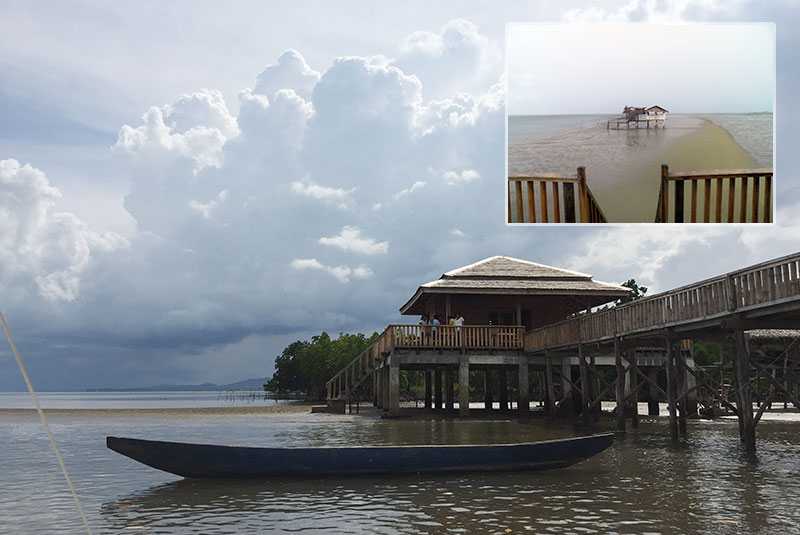Palawan new boom town for ecotourism through UNDP

Photo shows the station built by a non-government organization at the mouth of the Barbacan River in Barangay San Nicolas, Roxas town in Palawan, which is set to be transformed into a ‘visitor center’ complete with restaurant and nighttime firefly tour, while inset has the old decrepit one since declared unsafe. UNDP, Rainier Allan Ronda
Puerto Princesa City, Philippines – People’s organizations tapped to conserve protected forest and marine resource areas in Palawan’s provincial capital are set to become sustainable ecotourism enterprises with a little help from the United Nations Development Programme (UNDP).
With wealth creation provided by their ecotourism ventures, these organizations that hold community-based forest management agreements and marine protected areas are expected to become stronger and more sustainable, increasing their capacity to guard forests, marine areas and natural parks.
The Small Grants Program 5 (SGP 5) is a showcase of how the UNDP, joining forces with the government through the Department of Environment and Natural Resources-Biodiversity Management Bureau, and non-government organizations like the Palawan Conservation Corps and the Palawan Center for Appropriate Technology Inc. (PCART) as well as communities can enable these people’s organizations into becoming tourism entrepreneurs.
Ola Almgren, UNDP resident representative and coordinator, after a recent tour of several grantees and ongoing projects of the SGP 5 in Puerto Princesa City, said the earnestness of the community organizations was encouraging as well as inspiring.
“We are very encouraged and inspired by the progress of these community-based initiatives in making the natural beauty of Palawan more accessible to visitors while safeguarding its unique ecosystems and biodiversity,” Almgren said.
Almgren said that the SGP 5 was living up to its being a catalyst for government agencies and local government units to provide more investments in community organizations upon seeing the potential of the startup ecotourism ventures.
“UNDP’s support to these communities goes beyond the funding. We are very pleased to see how our relatively small grants to the communities are catalytic, not only to ensuring that the environment is conserved and protected, but also to paving the way for bigger efforts to spur development in these areas,” Almgren said.
A showcase among the SGP 5 projects in Palawan is that of PCART for the protection of mangrove areas along the Barbacan River, spanning seven barangays in the municipality of Roxas.
About half of the SGP 5 grant of P2.05 million was put into the construction of a new monitoring station replacing the decrepit old one at the mouth of the Barbacan River. The station guards stand watch at night against poachers from nearby Green Island as seaweed farmers are known to cut down mangrove trees for their seaweed pens and poles.
Lawrence Padilla, PCART executive director, said that community folks, mostly women the NGO was working with for the construction of the station, had seen the potential of opening a restaurant at the monitoring station, as well as a nighttime firefly tour along the river.
Padilla said that they saw no problem drawing customers to the firefly tour and restaurant, since there was a stream of tourists at two high-end resorts across Green Island Bay and Tambobong Bay at the mouth of the Barbacan – the Calixi and Modessa.
The proposed projects, he said, have gotten the support of the local government of Roxas, which had committed funds for the construction of a mangrove walk beside the monitoring station. The Palawan provincial government has committed funds to buy three kayaks and three boats so PCART can offer waterspout activities.
The SGP 5 has 18 other ongoing projects in the whole of Palawan, the province being one of three priority areas in the Philippines.
Grace Tena, program analyst of UNDP Philippines’ Inclusive and Sustainable Unit, said that the two other priority areas are Samar and the Sierra Madre range.
“The reason for the selection of these sites was that these are areas known to have very rich biodiversity,” Tena said.
The SGP heavily engaged NGOs and communities living around protected areas, she said. Funded by the Global Environment Facility (GEF), the projects are focused on biodiversity.
“We want to showcase in this project that global environmental benefits can be achieved through community initiatives. That’s the main objective of SGP 5,” Tena said.
“We have approved 19 projects in Sierra Madre, in Palawan 19, Samar 13 – so overall we have 51 small grants projects in these areas,” she said.
The GEF unites 183 countries in partnership with international institutions, civil society organizations and the private sector to address global environmental issues while supporting national sustainable development initiatives.
The facility was established in October 1991 as a $1-billion pilot program in the World Bank to assist in the protection of the environment and promote sustainable development.
- Latest



























